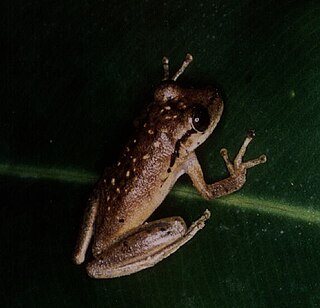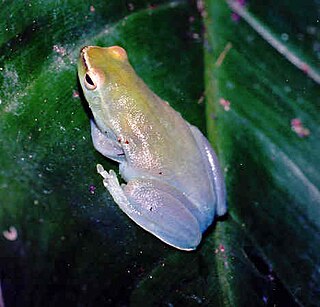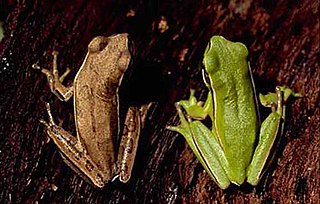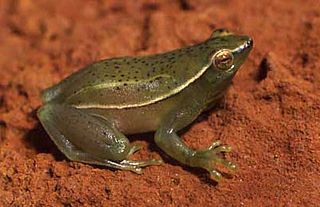
Hylidae is a wide-ranging family of frogs commonly referred to as "tree frogs and their allies". However, the hylids include a diversity of frog species, many of which do not live in trees, but are terrestrial or semiaquatic.

Scinax is a genus of frogs in the family Hylidae found in eastern and southern Mexico to Argentina and Uruguay, Trinidad and Tobago, and Saint Lucia. These are small to moderate-sized tree frogs, drably colored. Duellman and Wiens resurrected this genus in 1992. The name originates from the Greek word skinos, meaning quick or nimble.

Sphaenorhynchus is a genus of frogs in the family Hylidae. They are also known as lime treefrogs or hatchet-faced treefrogs. They are found in the Amazon and Orinoco River basins of South America, the Guianas, Trinidad, and southern and eastern Brazil. The majority of the species are associated with the Atlantic Forest domain in Brazil.
Xenohyla is a genus of tree frogs in the family Hylidae that is endemic to xeric habitats of coastal Brazil, with Xenohyla eugenioi native to the State of Bahia and the State of Sergipe, and Xenohyla truncata native to the State of Rio de Janeiro. This genus is characterized by a robust body, wide flat head, short snout, short forelimbs with muscular forearms, and a truncate-shaped body when viewed from above. They are associated with bromeliads, where they hide during the day and eat the insects that also inhabit the plant. They breed in temporary pools that are formed by rainwater. Both species are orange or brown with a white stripe going down their dorsal edges. X. truncata loses this stripe when it matures but X. eugenioi keeps it as an adult.

Phyllodytes is a genus of frogs in the family Hylidae. It is endemic to eastern Brazil.

Osteocephalus is a genus of frogs, the slender-legged tree frogs, in the family Hylidae found in the Guianas, the Amazon Basin, Venezuela, Colombia, southeastern Brazil, and north-eastern Argentina. Males are warty, while females are smooth.

The canebrake tree frogs are a frog genus Aplastodiscus. They are in the family Hylidae. Residing primarily in southeast regions of Brazil near the Atlantic coast. The exception is the Aplastodiscus perviridis which is found mostly in Brazil, but has also been documented being in Argentina, and might reside in Paraguay. The major revision of the Hylidae genus expanded it to include 12 more species originally from Hyla. Before the revision there were only 2 species. There are currently 16 described species with the most recent addition Aplastodiscus heterophonicus being described in 2021.

Nyctimantis is a genus of frogs in the family Hylidae. The genus is found in south-eastern Brazil as well as in the Orinoco Basin in Venezuela, Colombia, and Brazil. These are tree-dwelling species usually hiding in the cisterns of epiphytic bromeliads. The top of the head carries a bony plate which is fused with the skin.

Paulo Emilio Vanzolini was a Brazilian scientist and music composer. He was best known for his samba compositions, including the famous "Ronda", "Volta por Cima", and "Boca da Noite", and for his scientific works in herpetology. He is considered one of the greatest samba composers from São Paulo. Until his death, he still conducted research at the University of São Paulo (USP).

Bokermannohyla is a genus of frogs in the family Hylidae. It was erected in 2005 following a major revision of the Hylidae. Twenty-three species previously placed in the genus Hyla were moved to this genus named in honor of Werner Carlos Augusto Bokermann, Brazilian herpetologist. The genus is endemic to southern Brazil.

Dendropsophus is a genus of frogs in the family Hylidae. They are distributed in Central and South America, from southern Mexico to northern Argentina and Uruguay. They are sometimes known under the common name Fitzinger neotropical treefrogs or yellow treefrogs
Boana beckeri is a species of frog in the family Hylidae. It is endemic to Brazil and is only known from a handful of localities in southern Minas Gerais and adjacent northeastern São Paulo. The specific name beckeri honors Johann Becker, Brazilian zoologist who collected many of the types.
Boana latistriata is a species of frog in the family Hylidae. It is endemic to Brazil and only known from its type locality, Itatiaia National Park, and from Marmelópolis, both in the state of Minas Gerais. The specific name latistriata refers to the wide stripes on the back of this frog.

The Montevideo tree frog is a species of frog in the family Hylidae found in eastern, central, and northern Argentina, south-eastern Brazil, south-eastern Paraguay, and Uruguay. It is a common species occurring in open habitats in forests, grasslands, and flooded savannas. Breeding takes place in permanent ponds and flooded grasslands.

Itapotihyla is a genus of frogs in the family Hylidae. It is monotypic, being represented by the single species Itapotihyla langsdorffii, commonly known as the ocellated treefrog. It is found in the Atlantic Forest biome of Brazil, with an isolated population in eastern Paraguay and adjacent Brazil and northeastern Argentina.

Sphaenorhynchus surdus, or Cochran's lime treefrog, is a species of frog in the family Hylidae. It is endemic to southern Brazil and is known from the eastern Paraná, Santa Catarina, and northeastern Rio Grande do Sul states. Before Sphaenorhynchus caramaschii was described in 2007, all Sphaenorhynchus from the south of the state of São Paulo state all way south to Rio Grande do Sul were identified as S. surdus.

Xenohyla eugenioi is a species of tree frog in the Hylidae family native to northeastern Brazil in ecotones between the Atlantic Forest and caatingas. It has been found in the Brazilian states of Bahia and Sergipe, approximately 1,000 km away from the other species in its genus, Xenohyla truncata. Like its relative, this frog spends the day hiding in bromeliads, emerging at night to hunt and forage. This frog has been observed between 128 and 960 meters above sea level.
Bokermannohyla diamantina is a species of frogs in the family Hylidae. It is endemic to Brazil.
Scinax cabralensis is a species of frog in the family Hylidae. It is endemic to Brazil.
Ololygon faivovichi is a species of frog in the family Hylidae. It is endemic to Brazil.













